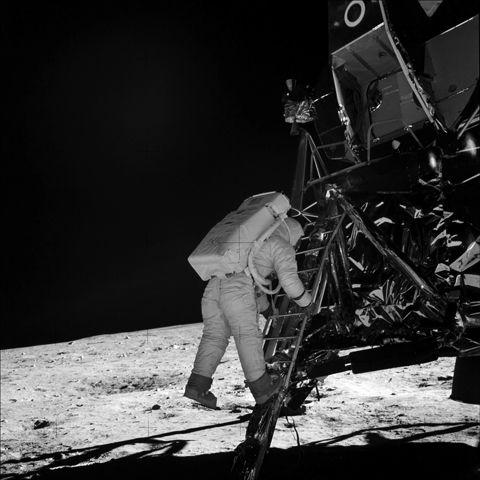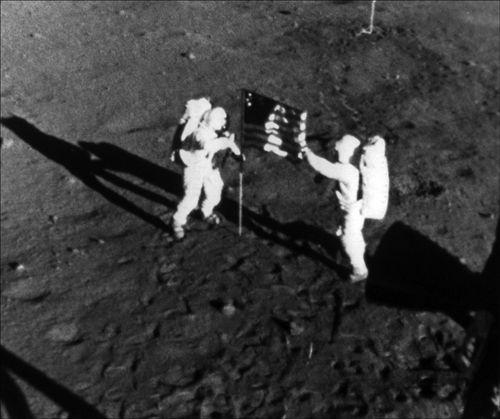Neil Armstrong: A Life of Flight (41 page)
Read Neil Armstrong: A Life of Flight Online
Authors: Jay Barbree
Tags: #Science, #Astronomy, #Biography & Autobiography, #Science & Technology

Pointing down from Eagle was a 16mm movie camera loaded with color film. It was there to film the actions of the two astronauts on the moon and Buzz told Neil, “Okay. I have got the camera on at one frame a second.”
“Okay.”
“Are you ready for me to come out?” asked Buzz.
“Yes,” Neil said and Buzz followed his instructions, asking, “How far are my feet from the edge?”
“You’re right at the edge of the porch.”
“Okay. Now I want to back up and partially close the hatch,” Buzz reported, quickly adding, “making sure not to lock it on my way out.”
“A very good thought,” Neil agreed, as a wave of laughter rolled through Mission Control.
* * *
Buzz moved slowly down and then said “Okay, I’m on the top step and I can look down over the landing gear pads. It’s a very simple matter to hop down from one step to the next.”
“Yes, I found I could be very comfortable, and walking is also very comfortable,” Neil agreed, pausing long enough to recheck Buzz’s progress. “You’ve got three more steps and then a long one.”
“Okay. I’m going to leave that one foot up there and both hands down to about the fourth rung up.”
“There you go.”
“Okay. Now I think I’ll do the same.”
“A little more,” Neil suggested, “about another inch.” There was a pause and then Neil shouted, “There, you got it!”
A second human was on the moon and Neil greeted Buzz at the bottom of the stairs as they again heard cheering in Mission Control.
“Beautiful view.” Buzz grinned.
“Isn’t that something?” Neil agreed.
“Magnificent desolation,” Buzz said with feeling as he stared at a sky that was the darkest of black. No blue. No birds. No green below. There were many shades of grey on the surface and areas of utter black where rocks cast their shadows from an unfiltered sun, but no real color. Possibly tan under certain lighting.

Buzz Aldrin moves down Eagle’s ladder to join Neil on the moon. (NASA)
The land curved gently but noticeably away—all the way out to the horizon that was only half the distance Buzz and Neil were used to seeing on Earth. But there on the moon, they could actually see they were standing on a sphere, and when they walked and looked down their motion fascinated them. Each time they took one of their half-walking and half-floating steps their boots set in motion a spray of lunar soil sailing outward and upward sharply and quickly without the hindrance of an atmosphere, and they even tried running and leaping strides that were impossible to do on Earth. But when they tried to sustain a jog, the mass and velocity created kinetic energy and stopping quickly was impossible.
It was as if they had found a new playground after school and they even tried bunny hopping, an assortment of moves, and they wished they could stay on their new playground until they had explored every nook, every cranny; so much to see and do and so little time.

Buzz is firmly on the moon. (NASA)

The second human was on the moon and Neil greeted Buzz with the cheers of Mission Control. (NASA)
But despite their wish to drink in this new and strange and beautiful and wonderful place, Neil and Buzz had to move on to their chores.
First they reset their television camera’s location 60 feet from Eagle. This would help Earthlings see some of the things they were seeing and it would let the world watch them go about their business.
Next on their list of duties was to plant the American flag. By international agreement no country could claim the moon, even the first to get there. That was stated firmly in a plaque on Eagle’s front leg.

A plaque announcing Neil’s and Buzz’s arrival on the moon is secured to one of Eagle’s legs. It is still there today for the next to come visiting. (NASA)
“For those who haven’t read the plaque,” Neil told the television viewers, “it says, ‘Here Man from the planet Earth first set foot upon the Moon, July 1969
A.D.
We came in peace for all mankind.’ It has the crewmembers’ signatures and the signature of the President of the United States.”
Neil and Buzz then unfurled an American flag stiffened with wire so that it would appear to fly on the airless moon. But the moon’s subsurface was so hard they could barely get its pole to stand. Once they did they moved back to clear the view of the 16mm color movie camera looking down from Eagle’s window.
Then there were other protocols to meet.

Despite difficulty caused by the moon’s hard subsurface, Neil and Buzz get the flag to stand. (NASA)
In the lunar dust, Neil and Buzz placed mementoes for the five-deceased American and Russian space flyers, Gus Grissom, Ed White, Roger Chaffee, Vladimir Komarov, and Yuri Gagarin (the first in space had died in a plane crash the year before), and one small cargo—private and honorable—carried by Neil. It was not to be divulged. It was a diamond-studded astronaut pin made especially for Deke Slayton by the three
Apollo 1
astronauts who planned to fly it on their mission before that dreadful fire. And there was one other remembrance. Very special and dear to Neil, a part of an unfinished life he so wanted to leave on the moon, and he did.
* * *
High overhead, aboard Columbia, Mike Collins continued orbiting the moon every two hours. “How’s it going?” he called.
“I guess you’re about the only person around that doesn’t have TV coverage of the scene,” CapCom told him.
“That’s all right. I don’t mind a bit. How’s the quality of the TV?”
“Oh, it’s beautiful, Mike. It really is. They’ve got the flag up now and you can see the stars and stripes on the lunar surface.”
“Beautiful. Just beautiful,” Mike Collins said, wishing he were there but knowing he had a much bigger job—keeping Neil and Buzz’s ride home waiting and ready.
* * *
So the estimated billion people on Earth watching could keep track, Neil relocated their television camera to its cable’s limits. Those viewing could now see even more and CapCom told him, “We’ve got a beautiful picture, Neil,” adding, “Could we get both of you on the camera for a minute, please?”
“Say again, Houston,” Neil asked.
“We’d like to get both of you in the field of view of the camera for a minute.”
Buzz was in the middle of setting up experiments and while he found the request puzzling, he moved in front of the camera.
“Neil and Buzz,” CapCom Bruce McCandless told them, “the President of the United States is in his office now and would like to say a few words to you, over.”
“That would be an honor,” Neil responded.
Buzz felt his heart increase its beats. He was surprised. Later Neil would tell him he had been told the president might call, but had not wanted to mention it until it was firm.
“Go ahead, Mr. President. This is Houston out.”
“Hello, Neil and Buzz,” President Richard Nixon began, “I’m talking to you by telephone from the Oval Room at the White House, and this certainly has to be the most historic telephone call ever made. I just can’t tell you how proud we all are of what you are doing for every American. This has to be the proudest day of our lives. And for people all over the world, I am sure they, too, join with Americans in recognizing what an immense feat this is. Because of what you have done, the heavens have become a part of man’s world. And as you talk to us from the Sea of Tranquility, it inspires us to redouble our efforts to bring peace and tranquility to Earth. For one priceless moment in the whole history of man, all the people on this Earth are truly one; one in their pride in what you have done, and one in our prayers that you will return safely to Earth.”
There was a long silence, a grateful silence by a listening world, and Neil responded. “Thank you, Mr. President. It’s a great honor and privilege for us to be here representing not only the United States but also men of peace of all nations, and with interest, and a curiosity, and a vision for the future. It’s an honor for us to be able to participate here today.”
“And thank you very much and I look forward,” President Nixon told Neil, “all of us look forward to seeing you on the
Hornet
on Thursday.”
“I look forward to that very much, sir,” Buzz joined in.
What Neil and Buzz would find in the future when they were making their world tour was that they would be greeted by people everywhere saying “we,” not just the United States, “We did it—we went to the moon!”
* * *
There was so much more they wanted to do but Buzz found the Sea of Tranquility more rugged than he’d expected. There were high and low areas—not the best place to set up the experiments but he managed to deploy a solar-powered seismometer to detect moonquakes and a laser reflector to help scientists measure the distance at any given time between Earth and the moon. Buzz and Neil were most pleased when Mission Control told them they were giving them an extra fifteen minutes.
Then when they had the solar-powered seismometer running, Tranquility Base appeared to be a fully operating scientific outpost. Neil left the experiments to Buzz and began moving about their landing site exploring on his own.
He quickly abandoned any thoughts of trying to reach and inspect that football field size crater he had to avoid during landing. But there was a smaller crater he’d flown over only about 200 feet away. He only thought about this one for a second and moved into quick strides to reach it. He found the smaller pit to be about 80 feet across and 15 to 20 feet deep. No larger than a good-size house.
